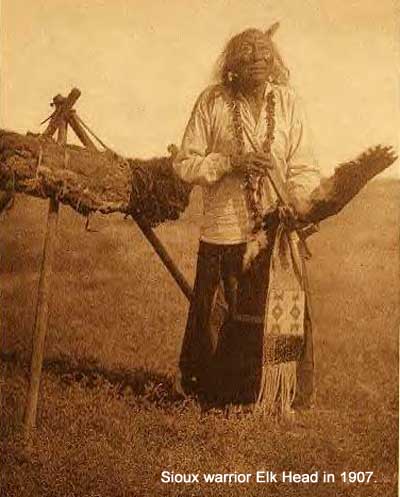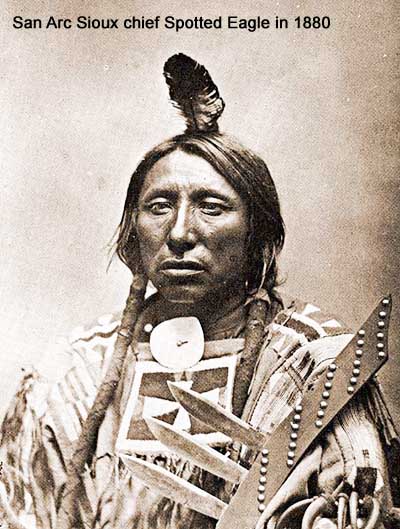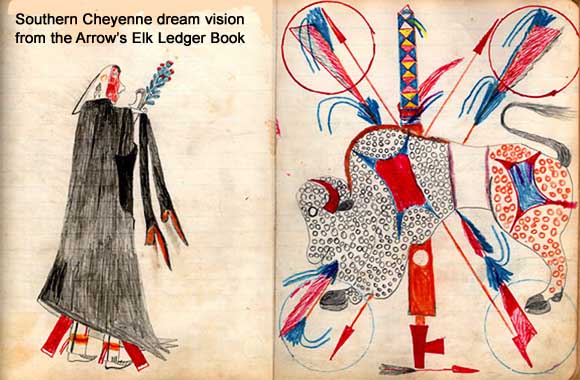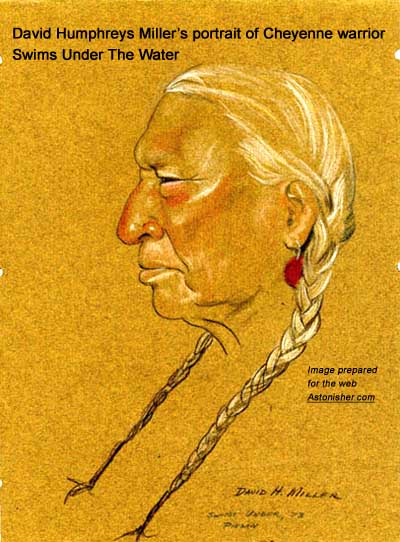|
||||||||||||
Bruce Brown's 100 Voices... Young Elk Head's Story of the Battle
YOUNG ELK HEAD AND TWO RUN'S STORY OF THE BATTLE
The history of the pipe was ancient, dating far beyond the earliest winter count which went back less than a century and a half. Long winters ago, during a time of great hunger, two Sansarc hunters once went out in search of game. Buffalo and elk and deer were scarce. Even pronghorn were not to be found. After days of fruitless hunting, the young men were nearly ready to give up and return emptyhanded to their camp. Great was their surprise when they suddenly encountered a beautiful Indian maiden, garbed in flowing white buckskin and carrying a sage bundle. When one of the young hunters had carnal desire for the maiden and approached her, a cloud enveloped them both. As it lifted, the other hunter saw the sacred maiden again, and at her feet his companion who had had impure thoughts was a bare skeleton, his flesh eaten from his bones by bloated snakes. "Behold!" cried the maiden to the good man who remained. "I am coming to your people, and will bring them something of great importance. Tell them to prepare for my coming." The good hunter obeyed and the sacred maiden soon visited the Sansarc village. To Standing Hollow Horn, who was then chief of the tribe, she gave solemn instruction. From the sage bundle she took a pipe. "With this sacred pipe," she said, "you will walk the Earth, which is your Mother as the Great Mystery is your Father. The bowl of this pipe is red stone; it is the Earth. Every step you take upon Her should be as a prayer. The stem of the pipe is wood, and represents all that grows upon the Earth. These twelve feathers that hang from the stem are from the Spotted Eagle, and represent all the winged things of the air. All things of the universe are joined to you who smoke this pipe. All send their voices to the Great Mystery, for when you pray with this pipe you pray for and with everything!" Presenting the pipe to Standing Hollow Horn, she said: "Behold this pipe! Always remember that it is sacred, and treat it as such, for it will take you to the end of time. I am leaving you now, but I shall always watch over your people. At the end I shall return to you again." So saying, the mysterious sacred maiden walked away, the people looking after her in amazement. Then before their eyes a strange thing happened: the maiden suddenly sat down on the ground, and when she rose she had become a white buffalo which trotted away over the hill.
The Sansarcs had been camped near the Black Hills that summer of 1874 when the soldiers came. None of the Sioux could understand then what the soldiers wanted in their country. But it did not seem the soldiers were interested in building towns or staying very long, so the Sioux made them welcome. Spotted Eagle and Fast Bear, chiefs of the Sansarcs, persuaded old Elk Head to arrange for them to smoke the Buffalo Calf Pipe with the long-haired leader of the soldiers, a ceremony which would serve the whites as assurance the Sioux wanted continued peace. It was a fine ritual. In smoking together, both parties pledged themselves to everlasting friendship and peace. The old days of war were gone forever, the long-haired soldier-chief promised, and no soldiers would ever attack Indians again. The Sioux took him at his word. But it was not long after that when the soldiers poked around in the ground and found much yellow metal considered sacred by white men. Thousands of whites poured into the Black Hills. The Sioux were shunted aside, even routed out of their old hunting grounds, so the whites could dig in the ground for the yellow metal. This time, the Sansarcs no longer bothered to assure the whites of their friendship, for they knew the white men did not mean what they said. Never again did the Sansarc chiefs invite a white man to smoke with them, but they always remembered that the only white man who ever did was the soldier-chief they called Long Hair [George Custer]. Custer's Fall: The Indian Side of the Story by David Humphreys Miller, University of Nebraska Press, Lincoln, NE 1957 p 57 - 60
Although too young to fight, Young Elk Head's account highlights an important element of the story -- the Sioux and Cheyenne's keen sense of betrayal by the Americans in general and Custer specifically, as portrayed here by what they took as Custer's callous disrespect for the sacred Buffalo Calf Pipe. * * *
Miller frequenlty made pastel sketches of the Sioux survivors of the Battle of the Little Bighorn whom he interviewed. Some of Miller's portraits are exceptionally fine evocations of the historic personalities in their own right, such as his portraits of Lazy White Bull and Old Eagle and Black Elk late in life. Click here for information of David Humphreys Miller's sources among the Sioux, Cheyenne, Crow, Arikara and Apapaho.
|
||||||||||||




 ALTHHOUGH too young to be full-fledged warriors, Elk Head and his brother Two Runs had a special reason for family pride. Their father, whose name was also
ALTHHOUGH too young to be full-fledged warriors, Elk Head and his brother Two Runs had a special reason for family pride. Their father, whose name was also  Elk Head and Two Runs knew the story well. Though not permitted to listen directly to religious talks that their father had with various holy men in the tribe, they had managed on several occasions to overhear him telling of the Buffalo Calf Pipe. And while they were not thinking of it particularly this morning, they remembered well the time two years ago when the pipe had been brought out for ceremonial smoking with a white soldier-chief.
Elk Head and Two Runs knew the story well. Though not permitted to listen directly to religious talks that their father had with various holy men in the tribe, they had managed on several occasions to overhear him telling of the Buffalo Calf Pipe. And while they were not thinking of it particularly this morning, they remembered well the time two years ago when the pipe had been brought out for ceremonial smoking with a white soldier-chief.
 Although not born into the Teton Sioux, David Humphreys Miller was adopted late in life by both
Although not born into the Teton Sioux, David Humphreys Miller was adopted late in life by both 







